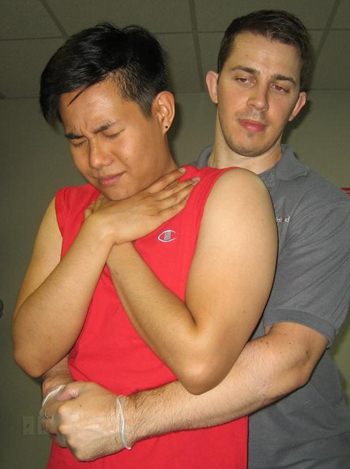The topics to write about each week come from many sources and ideas, and sometimes following a direct approach by one of the readers. This week is one of those, suggested by one of my faithful followers, Mrs. Laurance Fatus. Thank you for the interest and for the topic, which came after she witnessed a choking.

It was only while researching the Heimlich Maneuver that I began to see that there were elements of a good movie in all the history of Dr. Heimlich’s maneuver. Money, family jealousies and more money, interspersed with some ‘dodgy’ science. A blockbuster!
The good doctor Henry Heimlich has been called a “fraud” by his son Peter and criticized by many in the medical community for conducting studies on HIV patients in China – which were banned in the U.S. – that involved infecting them with malaria to cure the HIV. The technique was called “malariotherapy” and was used decades ago to treat syphilis but fell out of use because apparently too many patients were dying of malaria infections.
Heimlich (who was a thoracic surgeon) even admitted that he had never practiced his maneuver before publishing the details, and first tested his maneuver on dogs!
When questioned about this he is reported to have said, “I thought about writing a medical article, but if I waited for that to be published and for doctors to recommend it to patients to prevent choking to death, I knew it would take months or years for the word to spread. I did something fun, and I had a well-known medical journalist describe my dog study in a 1974 syndicated column picked up by hundreds of newspapers all around the country. A week later, an article appeared in the Seattle Times describing a man who tried the maneuver after reading about it, and he saved the life of his neighbor who was choking on a large piece of chicken.”
So how do you perform the maneuver? (The following is taken from Wikipedia.) “Performing abdominal thrusts involves a rescuer standing behind an upright patient and using his or her hands to exert pressure on the bottom of the diaphragm. This compresses the lungs and exerts pressure on any object lodged in the trachea, hopefully expelling it. This amounts to an artificially induced cough. For example, WebMD recommends the rescuer placing his or her fist just above the person’s bellybutton and grasping it with the other hand. To assist a larger person, more force may be needed. The Mayo Clinic recommends the same placement of fist and hand and upward thrusts as if you are trying to lift the person.
“If the victim is not upright, the US National Institutes of Health (NIH) recommends positioning the person on his or her back, then straddling the torso and using chest thrusts.
“It is possible for a still-conscious choking victim to perform the procedure on oneself, without assistance. The NIH recommends other procedures for children and for infants under a year old.
“Due to the forceful nature of the procedure, even when done correctly, abdominal thrusts can injure the person on whom it is performed. Bruising to the abdomen is highly likely and more serious injuries can occur, including fracture of the xiphoid process or ribs.”
The American Red Cross, one of the more sober organizations, removed the Heimlich maneuver from its primary recommendations in 2006, returning to promote the use of initial “back slaps” to dislodge the foreign body.
If the back slaps were unsuccessful, then the Heimlich could be used, but interestingly, removed the name Heimlich and replaced it with “abdominal thrusts”.
It should also be noted that there is no recommendation for the use of the Heimlich maneuver for drowning victims, and the authorities are saying that its use is contraindicated for victims, even though Dr. Heimlich claims it works.
So what to do for simple choking? Five forceful back slaps, then five Heimlich maneuvers. And hope a lot!




